Introduction to
Cryptography
Sahadeo Padhye
Associate Professor
Department of Mathematics
Motilal Nehru National Institute of Technology
Allahabad, India
Rajeev A. Sahu
Post-Doctoral Researcher
Departement d’Informatique
Université Libre de Bruxelles (ULB)
Brussels, Belgium
Vishal Saraswat
Visiting Scientist
R.C. Bose Centre for Cryptology and Security
Indian Statistical Institute
Kolkata, India
�
CRC Press
Taylor & Francis Group
6000 Broken Sound Parkway NW, Suite 300
Boca Raton, FL 33487-2742
© 2018 by Taylor & Francis Group, LLC
CRC Press is an imprint of Taylor & Francis Group, an Informa business
Version Date: 20180524
International Standard Book Number-13:
978-
1-138-07153-7
(Hardback)
Visit the Taylor & Francis Web site at
http://www.taylorandfrancis.com
and the CRC Press Web site at
http://www.crcpress.com
�
Foreword
Cryptography is an amazing science. It has been around for thousands of years, but
took off phenomenal strides less than fifty years ago. At the crossroads of mathematics,
computing, telecommunications networks and quantum physics, cryptography is
nowadays a field of abundant researches and applications. Essential for the smooth
running of the digital world in which we live, the learning of cryptography is therefore
today a necessity for any IT specialist.
It is in this context that Sahadeo Padhye, Rajeev Anand Sahu and Vishal Saraswat
offer us a new textbook on cryptography of very high quality. This book is an ideal
companion for any student in computer science, in mathematics or in engineering
who wishes to approach cryptography in a formal, scientific and rigorous manner.
The authors have succeeded in proposing a textbook that presents cryptography in
depth with a great deal of clarity.
This comprehensive and self-contained book introduces very clearly and
iteratively all the mathematical elements necessary to understand the cryptographic
tools presented afterwards. Indeed, the first five chapters will give readers the elements
of algebra, number theory, probability and complexity of algorithms that will allow
them to easily approach the next five chapters dedicated to the most fundamental tools
of cryptography such as encryption, hash functions and digital signatures.
For every discussed cryptographic aspect, the reader will find informal
explanations, formal definitions of all the underlying mathematical aspects, a clear
description of the cryptographic scheme itself, numerical examples and corresponding
exercises.
The reader will be taken on a journey from the oldest cryptographic algorithms
to the most modern cryptographic schemes. From the scytale to elliptic curves
cryptography.
Very complete, this book also presents really clear descriptions of most of
the essential algorithms needed to implement cryptographic schemes, such as the
computation of inverses, of square roots, primality tests, exponentiations, factorization,
discrete logarithm, etc.
�
Few books deal with so many different aspects of general cryptography in such
a didactic and comprehensive manner. All of this makes this introductory book on
cryptography by Sahadeo Padhye, Rajeev Anand Sahu and Vishal Saraswat a teaching
and pedagogical tool of quality, both for students or neophytes who are discovering
this exciting science and for teachers who need to set up a new course on this subject.
Olivier Markowitch
Brussels, December 2017
�
Preface
In the past three decades, study and research in cryptography has been growing.
‘Cryptography’ is no longer an unknown term. In many universities students are
studying cryptography in undergraduate and/or postgraduate courses, researchers are
involved in exploring various useful primitives of cryptography and many people
are using cryptography in their daily life, knowingly or unknowingly. Cryptography
has been practiced since long, but it has attracted the attention of researchers and
academicians in the last 30 years, since the elementary foundations proposed by
IBM (the Data Encryption Standard) in mid 1970s, Diffie and Hellman (the key
exchange protocol over the public network) in 1976 and by Rivest, Shamir and
Adleman (the RSA public key cryptosystem) in 1978. The idea of cryptography is
not independent of mathematics, in fact, major mathematical theories are at the core
of cryptography. This book presents an introduction to the notion of cryptography
and to the mathematical theories underlying the notion.
This book aims at readers who have some elementary background in mathematics
and are interested to learn cryptography. We have introduced basic techniques of
cryptography addressing the mathematical results used to establish those techniques.
In this way we achieve one of our goals, i.e. to provide mathematical structures
of basic cryptographic primitives and a list of ready reference to the students of
undergraduate and postgraduate with a possibility to cover major sections of their
syllabus of cryptography.
We have arranged the topics such that the mathematical theories have been
described before being mentioned in design and/or analysis of cryptographic schemes.
The book starts with an overview of cryptography which includes the goals of
cryptography and cryptanalysis. In the second chapter, we have provided definitions
from algebra that are essential in the formalization of various designs in later chapters.
Number theory captures important results of mathematics used in cryptography.
We have discussed many of these results with brief description in third chapter.
Probability and random numbers are other important notions used in design and
analysis of cryptographic algorithms. These theories have been covered in the fourth
chapter. The fifth chapter introduces the theory of complexity, which plays important
�
role in measure of strength of a cryptosystem. Thus, the first five chapters provide a
mathematical foundation. Hereafter, we start explaining the concepts of cryptographic
constructions. The explanation begins with description of the classical cryptosystems
in chapter six. The description of modern cryptographic designs starts with details of
symmetric key cryptography in chapter seven where we discuss various block ciphers.
The asymmetric cryptosystems (public key cryptosystems) are explained in chapter
nine. We have included description of digital signature, an important primitive of
public key cryptography, in an independent chapter, chapter ten. Hash function is an
integral ingredient of public key cryptography, it has been covered in chapters eight
to ten. Chapter 11 discusses emerging topics in cryptography.
The authors thank everyone due to whom this book could have come in its
current form. In particular, we are thankful to Vijay Primlani of Science Publishers
CRC Press, for giving us the opportunity to publish this work. We express our special
thanks to Prof. Olivier Markowitch who happily agreed to present his views about this
book in the foreword. We are also grateful to Gaurav Sharma and Veronika Kuchta,
postdoctoral researchers at ULB, Brussels, Belgium, for their useful suggestions
during discussions. Sonika Singh and Swati Rawal, Ph.D. students of Sahadeo Padhye
at MNNIT Allahabad, have extended their efforts in proofreading, we thank both of
them. Last, but not least, we thank our respective wives and children for their patient
and support during the writing of this book.
Sahadeo Padhye
Rajeev Anand Sahu
Vishal Saraswat
�
Contents
Foreword
Preface
1 Overview of Cryptography
1.1 Introduction
1.2 Goals of Cryptography
1.3 Classification of Cryptosystem
1.4 Practically Useful Cryptosystem
1.4.1 Confusion and Diffusion
1.5 Cryptanalysis
1.5.1 Types of Attackers
1.5.2 Types of Attacks
1.5.3 Security Notions
2 Basic Algebra
2.1 Group
2.2 Ring
2.3 Field
2.4 Exercises
2.3.1 Finite Field
2.3.2 Field Construction
2.3.3 Field Construction using Irreducible Polynomial
2.3.4 Galois Field GF(2n)
2.3.4.1
Integer Representation of Finite Field Elements
2.3.5 Field Construction using Generator
v
vii
1
2
3
4
5
6
7
7
8
9
11
12
15
16
17
18
19
19
20
22
23
�
3 Number Theory
3.1 Prime Numbers
3.2 Cardinality of Primes
3.3 Extended Euclidean Algorithm
3.4 Congruences
3.4.1 Solving Linear Congruence in Zn
3.4.2 Chinese Remainder Theorem (CRT)
3.5 Integer Factorization Problem
3.5.1 Trial Division Method
3.5.2 Fermat’s Method
3.5.3 Pollard’s p – 1 Method
3.5.4 Pollard’s Rho Method
3.5.5 Quadratic Sieve
3.5.6 Number Field Sieve
3.6 Primality Testing
3.6.1 Sieve of Eratosthenes
3.6.2 Divisibility Algorithm
3.6.3 AKS Algorithm
3.6.4 Fermat Test
3.6.5 Miller-Rabin Algorithm
3.7 Quadratic Congruence
3.7.1 Quadratic Residue or Non-Residue
3.7.2 Legendre Symbol and Jacobi Symbol
3.8 Exponentiation and Logarithm
3.8.1 Square and Multiply Method
3.9 Discrete Logarithm Problem
3.9.1 Shank’s Baby-Step Giant-Step Algorithm
3.9.2 Pollard’s Rho Algorithm
3.9.3 Pohlig-Hellman Algorithm
Index Calculus Algorithm
3.9.4
3.10 Exercises
4 Probability and Perfect Secrecy
4.1 Basic Concept of Probability
4.2 Birthday Paradox
4.3 Perfect Secrecy
4.4 Vernam One-Time Pad
4.5 Random Number Generation
4.6 Pseudo-random Number Generator
4.7 Exercises
25
26
27
29
32
33
34
35
35
36
37
39
40
41
41
41
42
42
43
43
45
45
46
50
50
51
52
53
56
58
59
61
62
64
66
68
69
69
70
�
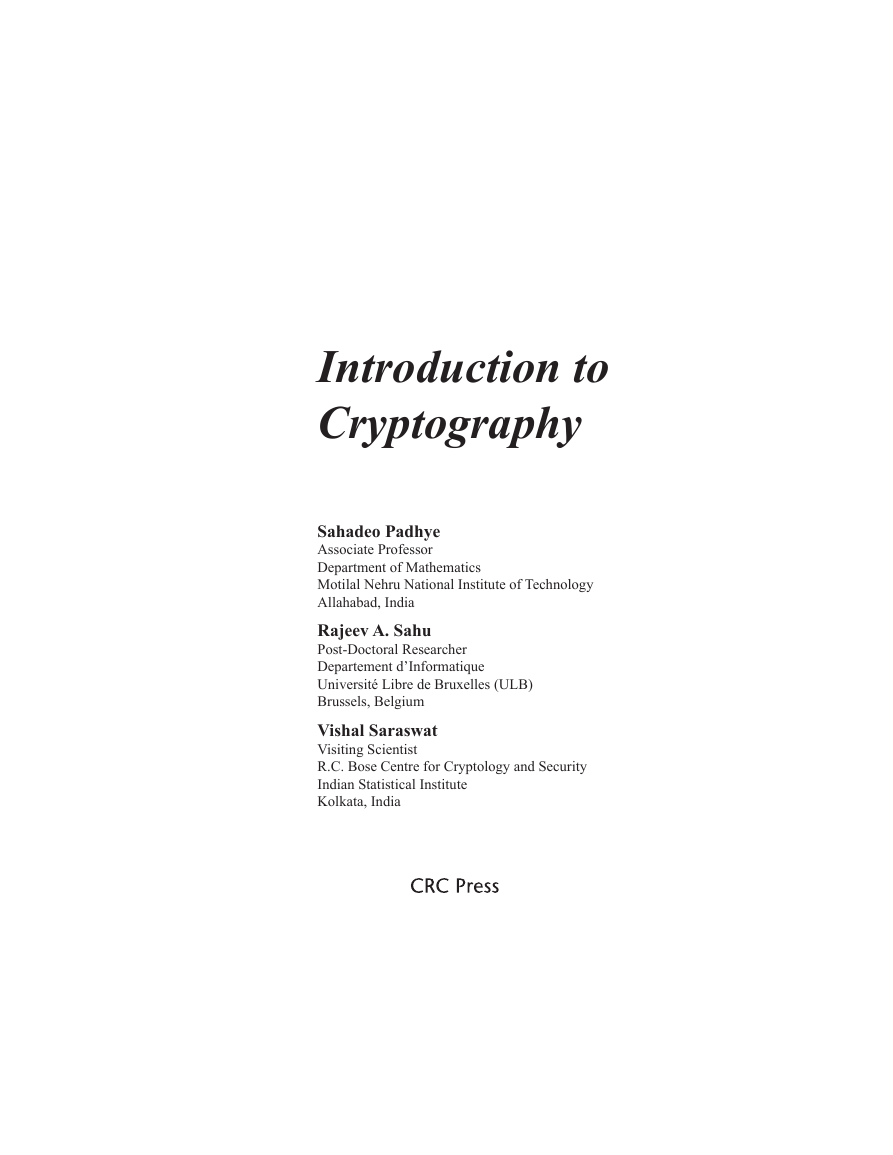

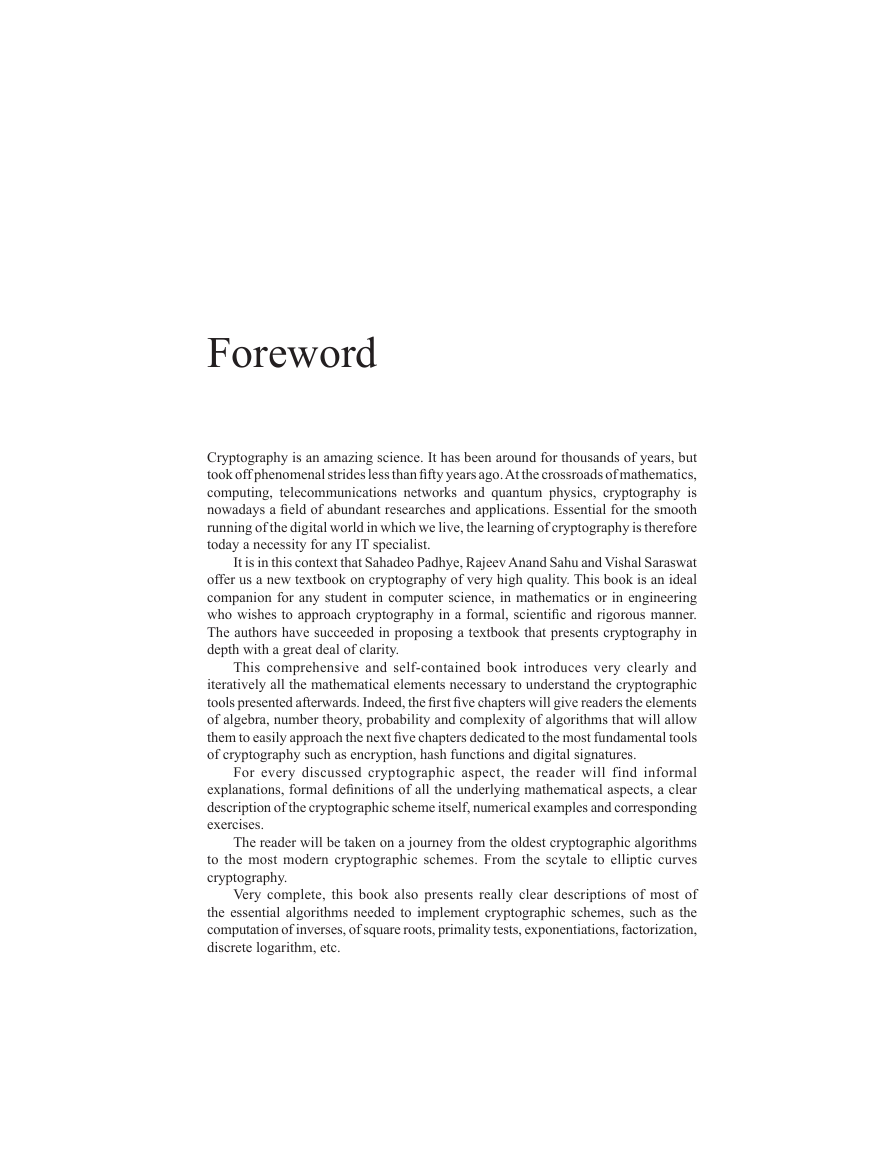
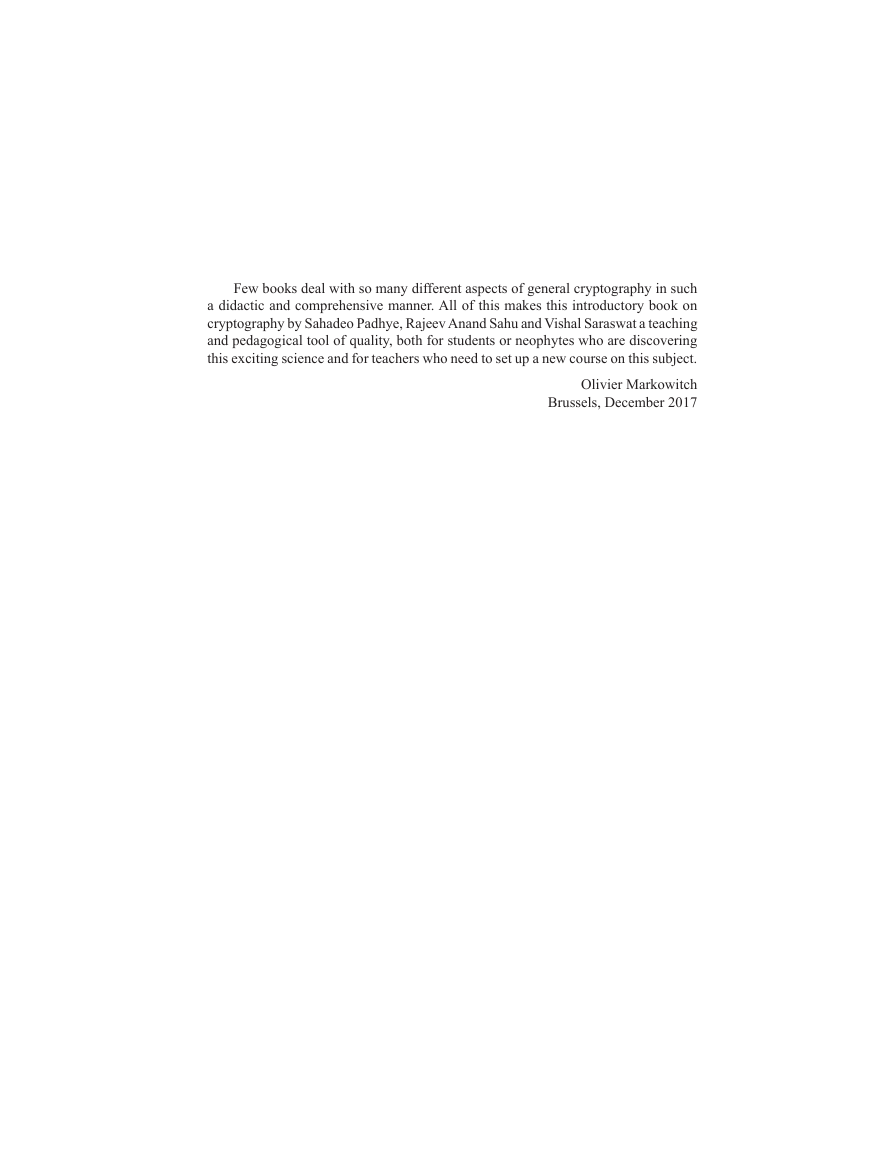
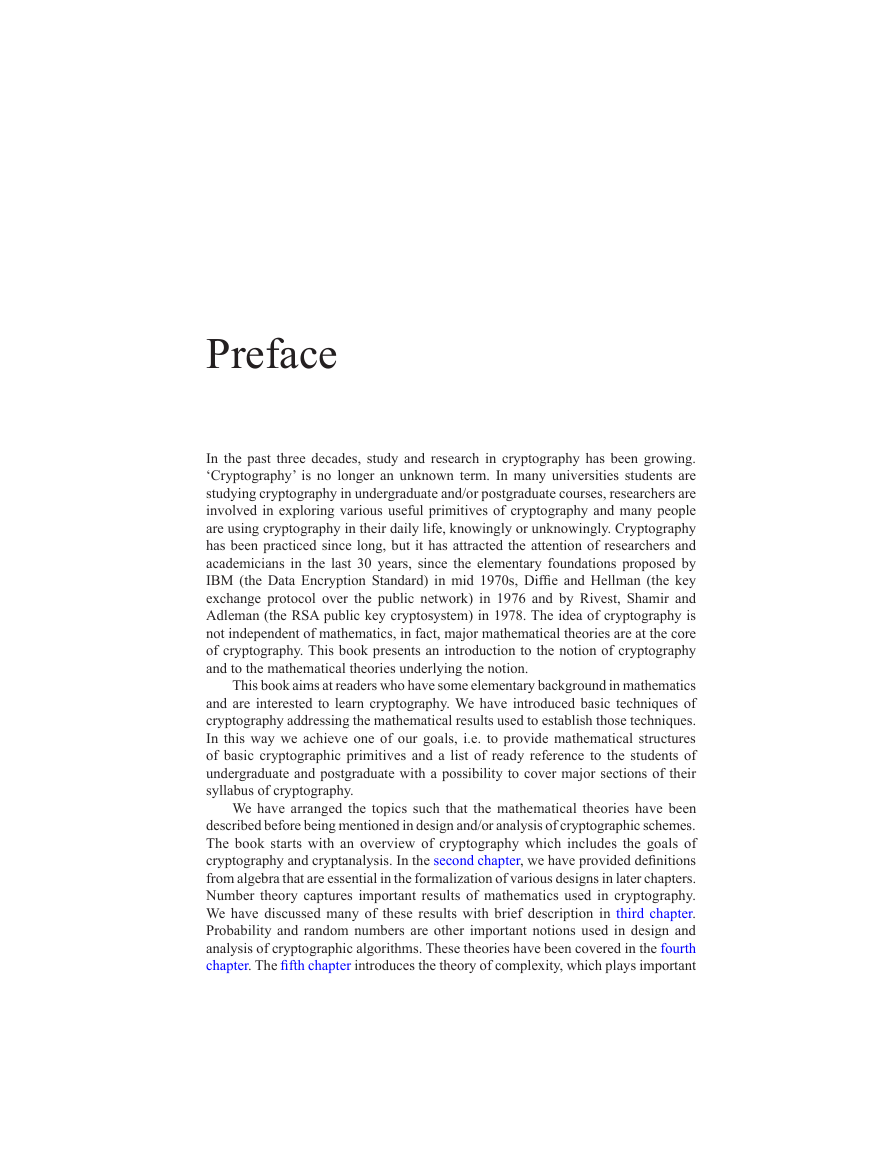
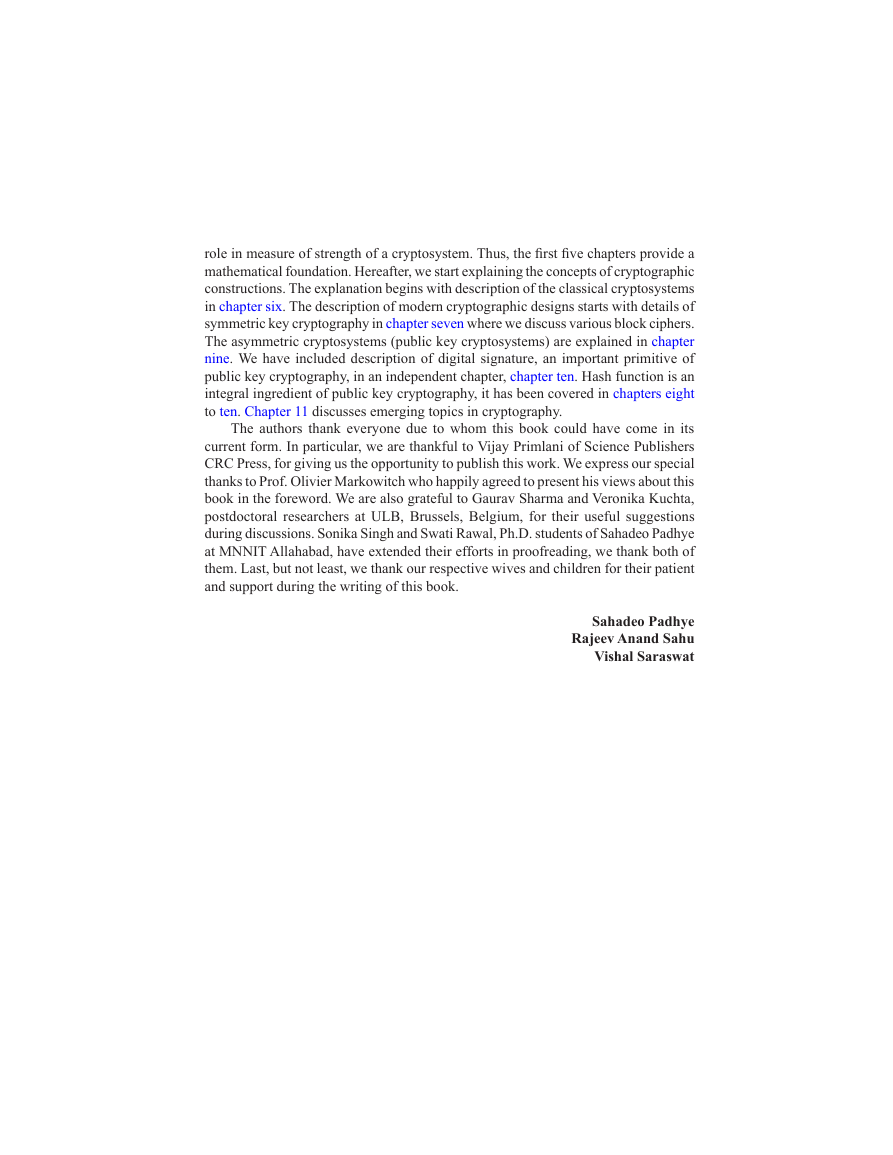
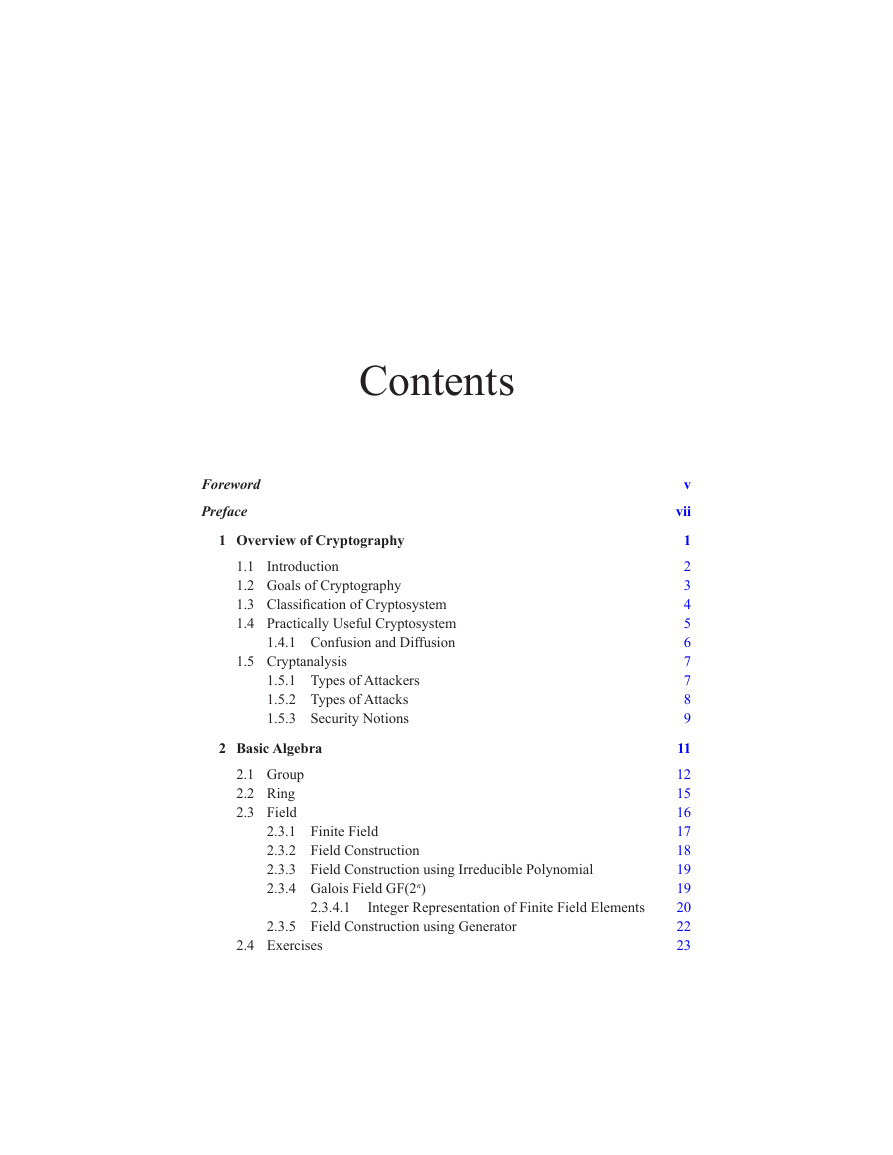
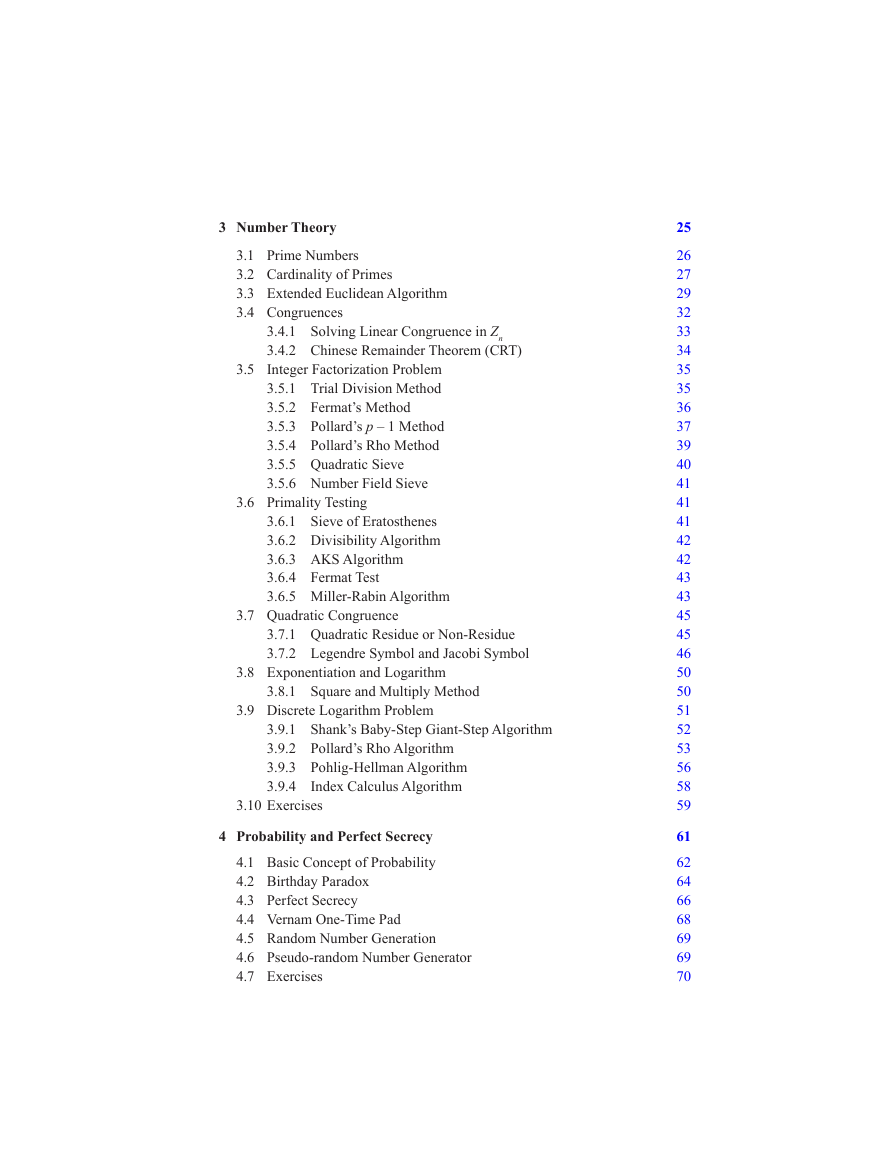








 2023年江西萍乡中考道德与法治真题及答案.doc
2023年江西萍乡中考道德与法治真题及答案.doc 2012年重庆南川中考生物真题及答案.doc
2012年重庆南川中考生物真题及答案.doc 2013年江西师范大学地理学综合及文艺理论基础考研真题.doc
2013年江西师范大学地理学综合及文艺理论基础考研真题.doc 2020年四川甘孜小升初语文真题及答案I卷.doc
2020年四川甘孜小升初语文真题及答案I卷.doc 2020年注册岩土工程师专业基础考试真题及答案.doc
2020年注册岩土工程师专业基础考试真题及答案.doc 2023-2024学年福建省厦门市九年级上学期数学月考试题及答案.doc
2023-2024学年福建省厦门市九年级上学期数学月考试题及答案.doc 2021-2022学年辽宁省沈阳市大东区九年级上学期语文期末试题及答案.doc
2021-2022学年辽宁省沈阳市大东区九年级上学期语文期末试题及答案.doc 2022-2023学年北京东城区初三第一学期物理期末试卷及答案.doc
2022-2023学年北京东城区初三第一学期物理期末试卷及答案.doc 2018上半年江西教师资格初中地理学科知识与教学能力真题及答案.doc
2018上半年江西教师资格初中地理学科知识与教学能力真题及答案.doc 2012年河北国家公务员申论考试真题及答案-省级.doc
2012年河北国家公务员申论考试真题及答案-省级.doc 2020-2021学年江苏省扬州市江都区邵樊片九年级上学期数学第一次质量检测试题及答案.doc
2020-2021学年江苏省扬州市江都区邵樊片九年级上学期数学第一次质量检测试题及答案.doc 2022下半年黑龙江教师资格证中学综合素质真题及答案.doc
2022下半年黑龙江教师资格证中学综合素质真题及答案.doc